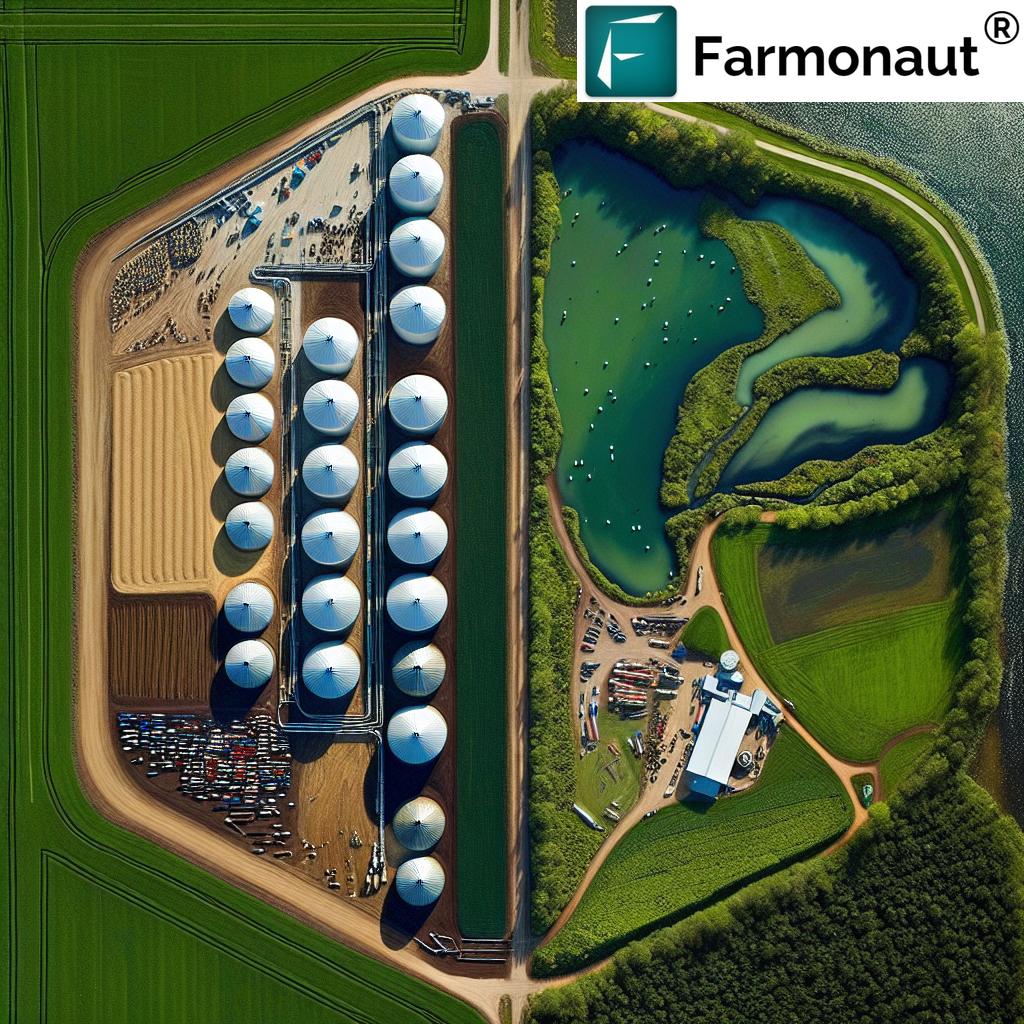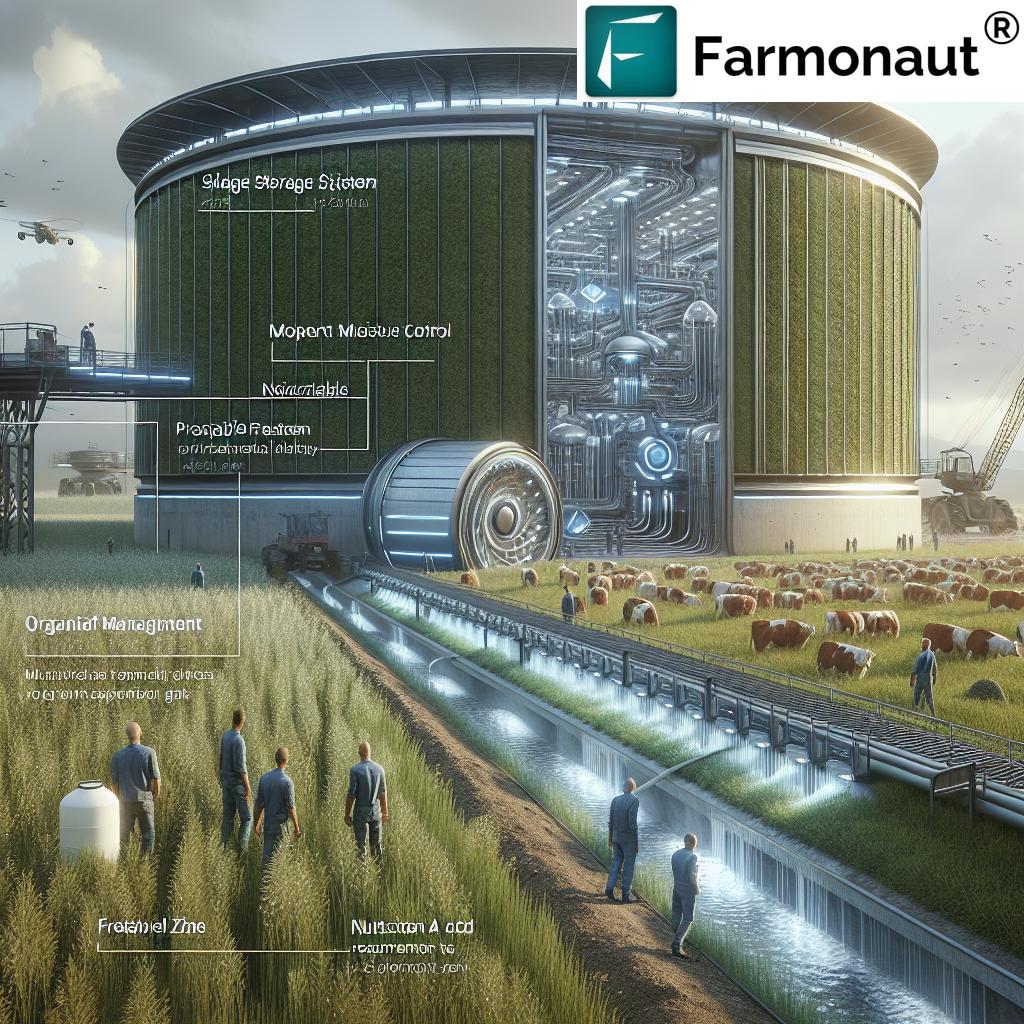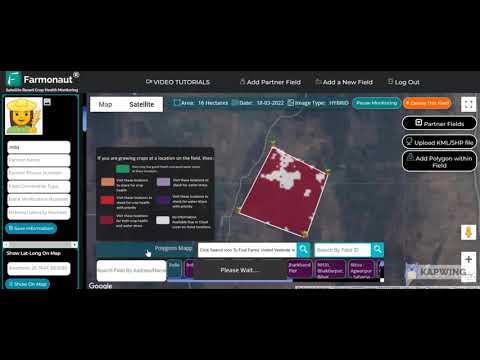Revolutionizing Farm Runoff Management: Farmonaut’s Precision Approach to Feed Storage Optimization in Wisconsin

“One acre of feed storage can equal the nutrient loss of 200 acres of cropland, highlighting the importance of optimizing silage storage.”
In the heart of America’s Dairyland, Wisconsin farmers are facing a crucial challenge that’s reshaping our understanding of agricultural sustainability. Recent research has unveiled a startling revelation: feed storage areas contribute significantly more to water runoff and nutrient loss than vast expanses of agricultural fields. This eye-opening discovery is prompting a revolution in farm management practices, with a particular focus on optimizing feed storage to mitigate environmental impact.
At Farmonaut, we’re at the forefront of this agricultural revolution, providing cutting-edge solutions that empower farmers to implement precision agriculture technologies effectively. Our satellite-based farm management platform is helping Wisconsin farmers transform their approach to nutrient management in agriculture and farm runoff prevention.
The Hidden Culprit: Feed Storage Areas
For years, the agricultural community has focused on field-based strategies to reduce nutrient runoff. However, recent studies have shifted our attention to a often-overlooked source of significant nutrient loss: feed storage areas. These compact zones, where silage and other livestock feeds are stored, are now recognized as hotspots for nutrient leaching and runoff.
- One acre of feed storage can contribute as much nutrient loss as 200 acres of cropland
- Uncovered silage piles are particularly vulnerable to precipitation and snowmelt
- Leachate from these areas is rich in nitrogen, phosphorus, and organic matter
This realization has spurred a paradigm shift in how we approach farm runoff prevention and agricultural water management. At Farmonaut, we’re dedicated to helping farmers implement sustainable farming practices that address these critical issues.
Understanding the Science Behind Feed Storage Runoff
To effectively tackle the challenge of feed storage runoff, it’s crucial to understand the underlying processes. When precipitation or snowmelt comes into contact with stored feed, particularly silage, it can lead to the formation of nutrient-rich leachate. This liquid is often highly acidic and contains elevated levels of nitrogen, phosphorus, and organic compounds.
- Silage leachate can have a pH as low as 4.0
- Nitrogen concentrations in leachate can be up to 6,000 mg/L
- Phosphorus levels can reach 1,500 mg/L
These concentrations are orders of magnitude higher than what’s typically found in field runoff, explaining why a relatively small feed storage area can have such a disproportionate impact on nutrient loss.
Silage Storage Best Practices
Implementing effective silage storage practices is key to reducing nutrient loss and protecting water quality. Here are some critical strategies:
- Proper Site Selection: Choose well-drained areas away from water bodies
- Adequate Covering: Use high-quality plastic covers to prevent water infiltration
- Efficient Drainage Systems: Install systems to collect and manage leachate
- Regular Maintenance: Inspect and repair covers promptly to prevent damage
By adopting these silage storage best practices, farmers can significantly reduce the environmental impact of their feed storage areas.
Forage Harvesting Techniques for Optimal Storage
The quality of stored feed begins in the field. Implementing proper forage harvesting techniques is crucial for minimizing nutrient loss during storage:
- Optimal Moisture Content: Harvest at the right moisture level (30-35% for corn silage, 60-70% for haylage)
- Proper Chop Length: Ensure correct particle size for effective packing
- Rapid Filling and Packing: Minimize air exposure to promote proper fermentation
- Use of Inoculants: Consider bacterial additives to enhance fermentation
These techniques not only improve feed quality but also reduce the potential for nutrient leaching during storage.
Farmonaut’s Role in Feed Storage Optimization
At Farmonaut, we’re committed to providing farmers with the tools they need to optimize their feed storage practices. Our satellite-based monitoring system offers real-time insights into field conditions, helping farmers make informed decisions about harvest timing and moisture content.
Our platform integrates various data points, including:
- Vegetation health indices (NDVI)
- Soil moisture levels
- Weather forecasts
- Historical crop performance data
By leveraging this information, farmers can optimize their forage harvesting techniques, ensuring that crops are harvested at the ideal time for silage production.
Precision Agriculture Technologies for Nutrient Management
Precision agriculture is revolutionizing how we approach nutrient management in agriculture. These technologies allow for targeted application of inputs, reducing waste and minimizing the potential for nutrient runoff. Farmonaut’s platform integrates seamlessly with various precision agriculture tools, providing a comprehensive solution for farm management.
- Variable Rate Application (VRA) of fertilizers
- GPS-guided equipment for accurate field operations
- Remote sensing for crop health monitoring
- Soil mapping for targeted management zones
By adopting these technologies, farmers can optimize their resource use, improve crop yields, and reduce their environmental footprint.
The Impact of Feed Storage Optimization on Water Quality
Implementing proper feed storage practices and utilizing precision agriculture technologies can have a profound impact on water quality in agricultural regions. By reducing nutrient runoff from feed storage areas, we can:
- Decrease algal blooms in nearby water bodies
- Improve aquatic ecosystem health
- Protect groundwater resources from contamination
- Enhance the overall sustainability of farming operations
These benefits extend far beyond the farm, contributing to the health of entire watersheds and communities.
Comparative Analysis: Feed Storage vs. Agricultural Fields
| Nutrient Loss Factor | Feed Storage Area (1 acre) | Agricultural Field (200 acres) |
|---|---|---|
| Nitrogen Runoff (lbs/year) | 1,500 | 800 |
| Phosphorus Runoff (lbs/year) | 300 | 100 |
| Potassium Runoff (lbs/year) | 2,000 | 600 |
| Covered vs. Uncovered Silage (% reduction) | 80% | N/A |
| Optimal vs. Suboptimal Moisture Levels (% reduction) | 50% | 20% |
| Total Environmental Impact Score (1-10) | 9 | 4 |
This table clearly illustrates the disproportionate impact of feed storage areas on nutrient loss compared to agricultural fields. It underscores the importance of focusing on feed storage optimization as a key strategy for reducing farm runoff and improving overall agricultural sustainability.
Soil Health Improvement Through Proper Feed Management
Optimizing feed storage not only reduces nutrient runoff but also contributes to improved soil health. By minimizing leachate and preventing the loss of valuable nutrients, farmers can maintain healthier soils that are more resilient and productive.
- Reduced soil acidification from silage leachate
- Improved soil organic matter content
- Enhanced soil microbial activity
- Better water retention capacity
Farmonaut’s satellite-based monitoring system helps farmers track soil health indicators over time, allowing for data-driven decisions in soil management practices.
Innovative Techniques for Capturing Nutrient-Rich Liquids
To further reduce the environmental impact of feed storage areas, innovative techniques are being developed to capture and utilize nutrient-rich liquids:
- Vegetative Filter Strips: Natural barriers that filter runoff
- Constructed Wetlands: Engineered systems for treating leachate
- Anaerobic Digestion: Converting leachate into biogas and fertilizer
- Precision Collection Systems: Advanced drainage and storage solutions
These techniques not only prevent nutrient loss but also create opportunities for resource recovery and circular agriculture practices.
The Role of Weather Monitoring in Feed Storage Management
Effective feed storage management requires a keen understanding of weather patterns and their impact on storage conditions. Farmonaut’s platform provides real-time weather data and forecasts, enabling farmers to:
- Anticipate heavy rainfall events and take preventive measures
- Optimize timing for silage covering and uncovering
- Plan for snowmelt management in winter months
- Adjust feed storage practices based on seasonal weather trends
By integrating weather monitoring into feed storage management, farmers can proactively address potential runoff issues and maintain optimal storage conditions.
Economic Benefits of Optimized Feed Storage
While the environmental benefits of optimized feed storage are clear, there are also significant economic advantages for farmers:
- Reduced feed spoilage and waste
- Improved feed quality leading to better livestock performance
- Lower fertilizer costs due to reduced nutrient loss
- Potential for carbon credits or environmental incentives
Farmonaut’s platform helps farmers quantify these economic benefits, providing a clear return on investment for implementing best practices in feed storage management.
Case Study: Wisconsin Dairy Farm Transformation
To illustrate the real-world impact of optimized feed storage, let’s consider a hypothetical case study of a Wisconsin dairy farm:
- Farm Size: 500 acres
- Herd Size: 200 dairy cows
- Previous Feed Storage: Uncovered bunker silo
- Implemented Changes:
- Covered silage with high-quality plastic
- Installed leachate collection system
- Optimized harvesting moisture content
- Utilized Farmonaut’s platform for precision management
- Results:
- 70% reduction in nutrient runoff from feed storage area
- 15% improvement in feed quality
- 10% increase in milk production
- $20,000 annual savings in feed and fertilizer costs
This case study demonstrates the significant environmental and economic benefits that can be achieved through optimized feed storage practices and the use of precision agriculture technologies.
Future Directions in Feed Storage Research
As we continue to advance our understanding of feed storage optimization, several exciting research directions are emerging:
- Development of biodegradable silage covers
- Advanced sensors for real-time monitoring of silage conditions
- AI-driven predictive models for optimizing storage management
- Novel additives to enhance nutrient retention in stored feed
Farmonaut is committed to staying at the forefront of these developments, continuously improving our platform to provide farmers with the most advanced tools for feed storage optimization.
Collaborative Approaches to Farm Runoff Prevention
Addressing the challenge of farm runoff requires a collaborative approach involving farmers, researchers, policymakers, and technology providers. Farmonaut is proud to be part of this collective effort, contributing our expertise in satellite-based monitoring and precision agriculture.
Key collaborative initiatives include:
- Farmer-led watershed groups
- Public-private partnerships for technology development
- Educational programs on best management practices
- Policy frameworks that incentivize sustainable farming practices
By working together, we can create a more sustainable and resilient agricultural system that protects our water resources while supporting productive farming.
Implementing Farmonaut’s Solutions for Feed Storage Optimization
Farmers looking to optimize their feed storage practices can easily get started with Farmonaut’s platform:
- Sign up for a Farmonaut account
- Input farm boundaries and crop types
- Access real-time satellite imagery and analytics
- Utilize AI-driven insights for decision-making
- Monitor progress and adjust practices as needed
Our user-friendly interface and comprehensive support ensure that farmers of all technical backgrounds can leverage the power of precision agriculture for feed storage optimization.
Conclusion: A Sustainable Future for Wisconsin Agriculture
As we’ve explored throughout this article, optimizing feed storage is a critical component of sustainable farming practices in Wisconsin and beyond. By focusing on this often-overlooked aspect of farm management, we can dramatically reduce nutrient runoff, improve water quality, and enhance overall farm productivity.
Farmonaut is committed to supporting farmers in this important transition, providing the tools and insights needed to implement precision agriculture technologies effectively. Together, we can revolutionize farm runoff management and create a more sustainable future for agriculture.
FAQs
- Q: How does Farmonaut’s technology help in feed storage optimization?
A: Farmonaut’s satellite-based monitoring system provides real-time data on crop health, soil moisture, and weather conditions, helping farmers make informed decisions about harvest timing and storage practices. - Q: What are the main benefits of optimizing feed storage?
A: The main benefits include reduced nutrient runoff, improved feed quality, lower environmental impact, and potential cost savings on feed and fertilizer. - Q: How can farmers get started with Farmonaut’s platform?
A: Farmers can sign up for a Farmonaut account, input their farm boundaries, and start accessing satellite imagery and analytics immediately. - Q: Is Farmonaut’s technology suitable for small farms?
A: Yes, Farmonaut’s platform is designed to be scalable and accessible for farms of all sizes, from small family operations to large commercial farms. - Q: How often is the satellite data updated?
A: The frequency of satellite data updates varies depending on the subscription plan, but typically ranges from daily to weekly updates.

“Recent research shows feed storage areas contribute significantly more to water runoff and nutrient loss than agricultural fields.”
For more information on Farmonaut’s API capabilities, visit our API documentation and developer resources.




